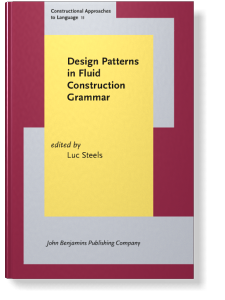Construction Grammar is enthusiastically embraced by a growing group of linguists who find it a natural way to formulate their analyses. But so far there is no widespread formalization of construction grammar with a solid computational implementation. Fluid Construction Grammar attempts to fill this gap. It is a fully operational computational framework capturing many key concepts in construction grammar. The present book is the first extensive publication describing this framework. In addition to general introductions, it gives a number of concrete examples through a series of linguistically challenging case studies, including phrase structure, case grammar, and modality. The book is suited both for linguists who want to know what Fluid Construction Grammar looks like and for computational linguists who may want to use this computational framework for their own experiments or applications.
Reviews of the book
- Computational Linguistics, by Nathan Schneider (Carnegie Mellon University) and Reut Tsarfaty (Uppsala University)
Demonstrations, source code and samples
- You can find interactive web demonstrations of the examples discussed in the book in our demonstrations page.
- For downloading Fluid Construction Grammar, please click here. Sample code that illustrates the materials in the book are collected under your-babel2-folder/demos/design-patterns-in-fcg/.
Contributions
Part I: Introduction
Introducing Fluid Construction Grammar Book Section
In: Steels, Luc (Ed.): Design Patterns in Fluid Construction Grammar, pp. 3-30, John Benjamins, Amsterdam, 2011.
A First Encounter with Fluid Construction Grammar Book Section
In: Steels, Luc (Ed.): Design Patterns in Fluid Construction Grammar, pp. 31-68, John Benjamins, Amsterdam, 2011.
Part II: Grammatical Structures
A Design Pattern for Phrasal Constructions Book Section
In: Steels, Luc (Ed.): Design Patterns in Fluid Construction Grammar, pp. 71-114, John Benjamins, Amsterdam, 2011.
A Design Pattern for Argument Structure Constructions Book Section
In: Steels, Luc (Ed.): Design Patterns in Fluid Construction Grammar, pp. 115-145, John Benjamins, Amsterdam, 2011.
Part III: Managing Processing
Search in Linguistic Processing Book Section
In: Steels, Luc (Ed.): Design Patterns in Fluid Construction Grammar, pp. 149-179, John Benjamins, Amsterdam, 2011.
Organizing Constructions in Networks Book Section
In: Steels, Luc (Ed.): Design Patterns in Fluid Construction Grammar, pp. 181-201, John Benjamins, Amsterdam, 2011.
Part IV:Case Studies
Feature Matrices and Agreement: A Case Study for German Case Book Section
In: Steels, Luc (Ed.): Design Patterns in Fluid Construction Grammar, pp. 205-235, John Benjamins, Amsterdam, 2011.
Syntactic Indeterminacy and Semantic Ambiguity: A Case Study for German Spatial Phrases Book Section
In: Steels, Luc (Ed.): Design Patterns in Fluid Construction Grammar, pp. 265-298, John Benjamins, Amsterdam, 2011.
Part V: Fluidity and Robustness
How to Make Construction Grammars Fluid and Robust Book Section
In: Steels, Luc (Ed.): Design Patterns in Fluid Construction Grammar, pp. 301-330, John Benjamins, Amsterdam, 2011.
Errata
- p. 55 and 57: (string
mouse-unit“mouse”) => (string ?mouse-unit “mouse”) - p. 116: Steels (
2012a) => Steels (2011a) - p. 123: van Trijp (2012) => (van Trijp, 2011)
- p. 207:
van Trijp (2012)=> (van Trijp, 2011) - p. 209: der Lehrerin is unambiguously assigned
accusativecase => der Lehrerin is unambiguously assigned dative case - p. 224: van Trijp (
2012) => van Trijp (2011) - p. 230: Beuls (
2012) => Beuls (2011) - p. 231: Beuls,
2012=> Beuls, 2011 - p. 235-236: Two last references of the paper are missing:
> Steels, Luc, Pieter Wellens (2006). (2006). How grammar emerges to dampen combinatorial search in parsing. In P. Vogt, Y. Sugita, E. Tuci, C. Nehaniv (Eds.), Symbol Grounding and Beyond. Proceedings of the Third EELC, LNAI 4211, 76–88. Berlin: Springer-Verlag.
> van Trijp, Remi (2011). A Design Pattern for Argument Structure Constructions. In Luc Steels (Ed.), Design Patterns in Fluid Construction Grammar. Amsterdam: John Benjamins. - p. 237: “considered in
the next chapter(Wellens 2011)” => “considered in a previous chapter (Wellens 2011)” - p. 252 “(
see gerasymova)” => “(for a detailed discussion, see (Gerasymova 2012))” - p. 306: Bleys, et al.,
2012=> Bleys, et al., 2011 - p. 314, 315 and 317: Steels (
2012) => Steels (2011)
